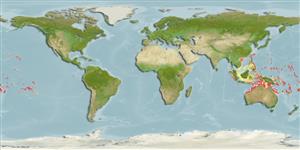Teleostei (teleosts) >
Eupercaria/misc (Various families in series Eupercaria) >
Labridae (Wrasses) > Corinae
Etymology: Halichoeres: Greek, als, alis = salt + Greek, choiros = pig (Ref. 45335); claudia: Named in honor of the 2nd author’s wife, also a marine biologist, for her continued support and help with lab work. The species name is treated as a noun in apposition (Ref. 82288).
Eponymy: Claudia Rocha is the wife of the second author, Luiz Rocha. [...] (Ref. 128868), visit book page.
More on authors: Randall & Rocha.
Environment: milieu / climate zone / depth range / distribution range
Ecology
Marine; benthopelagic; depth range 1 - 35 m (Ref. 90102), usually 1 - 24 m (Ref. 82288). Tropical; 6°N - 24°S, 96°E - 149°W
Pacific Ocean: from the Line Is. and islands of French Polynesia to the western Pacific. where it is reported from the Great Barrier Reef, New Caledonia, Vanuatu, and Indonesia (from underwater photographs in Flores and Gunung Api in the Banda Sea. The species is also found in the eastern Indian Ocean at Christmas I., the Cocos-Keeling Is. (in addition to the paratypes from this locality, 1 nontype specimen is reported from the Western Australian Museum (WAM P.29064-002, 64 mm SL) and 2 from Cartier I. in the Timor Sea (Ref. 82288).
Length at first maturity / Size / Weight / Age
Maturity: Lm 5.0, range 4 - 5.2 cm
Max length : 8.8 cm SL male/unsexed; (Ref. 82288); 5.6 cm SL (female)
Found solitary usually on outer slopes of reefs 1-35 m deep. Formerly identified as H. ornatissimus which is restricted to Hawaiian Islands and Johnston Island (Ref. 90102).
Life cycle and mating behavior
Maturity | Reproduction | Spawning | Eggs | Fecundity | Larvae
Distinct pairing. Males build dish shaped nest and guard eggs (Ref. 205). Size at sex change may begin from 5.4 cm SL (Ref. 82288).
Randall, J.E. and L.A. Rocha, 2009. Halichoeres claudia sp. nov., a new Indo-Pacific wrasse (Perciformes: Labridae), the fourth species of the H. ornatissimus complex. Zool. Stud. 48(5):709-718. (Ref. 82288)
IUCN Red List Status (Ref. 130435: Version 2024-1)
Threat to humans
Harmless
Human uses
Tools
Special reports
Download XML
Internet sources
Estimates based on models
Preferred temperature (Ref.
123201): 24.7 - 29, mean 27.5 °C (based on 362 cells).
Phylogenetic diversity index (Ref.
82804): PD
50 = 0.5000 [Uniqueness, from 0.5 = low to 2.0 = high].
Bayesian length-weight: a=0.00977 (0.00468 - 0.02039), b=3.09 (2.92 - 3.26), in cm total length, based on LWR estimates for this Genus-body shape (Ref.
93245).
Trophic level (Ref.
69278): 3.4 ±0.5 se; based on size and trophs of closest relatives
Fishing Vulnerability (Ref.
59153): Low vulnerability (10 of 100).
Nutrients (Ref.
124155): Calcium = 289 [150, 593] mg/100g; Iron = 1.18 [0.58, 2.50] mg/100g; Protein = 16.5 [13.6, 18.6] %; Omega3 = 0.171 [0.079, 0.363] g/100g; Selenium = 42.8 [18.2, 99.8] μg/100g; VitaminA = 72.1 [16.7, 309.3] μg/100g; Zinc = 2.32 [1.47, 3.77] mg/100g (wet weight);
